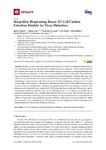Simplified Bioprinting-Based 3D Cell Culture Infection Models for Virus Detection
Koban, Robert
Lam, Tobias
Schwarz, Franziska
Kloke, Lutz
Bürge, Silvio
Ellerbrok, Heinz
Neumann, Markus
Studies of virus–host interactions in vitro may be hindered by biological characteristics of conventional monolayer cell cultures that differ from in vivo infection. Three-dimensional (3D) cell cultures show more in vivo-like characteristics and may represent a promising alternative for characterisation of infections. In this study, we established easy-to-handle cell culture platforms based on bioprinted 3D matrices for virus detection and characterisation. Different cell types were cultivated on these matrices and characterised for tissue-like growth characteristics regarding cell morphology and polarisation. Cells developed an in vivo-like morphology and long-term cultivation was possible on the matrices. Cell cultures were infected with viruses which differed in host range, tissue tropism, cytopathogenicity, and genomic organisation and virus morphology. Infections were characterised on molecular and imaging level. The transparent matrix substance allowed easy optical monitoring of cells and infection even via live-cell microscopy. In conclusion, we established an enhanced, standardised, easy-to-handle bioprinted 3D-cell culture system. The infection models are suitable for sensitive monitoring and characterisation of virus–host interactions and replication of different viruses under physiologically relevant conditions. Individual cell culture models can further be combined to a multicellular array. This generates a potent diagnostic tool for propagation and characterisation of viruses from diagnostic samples.
Files in this item

